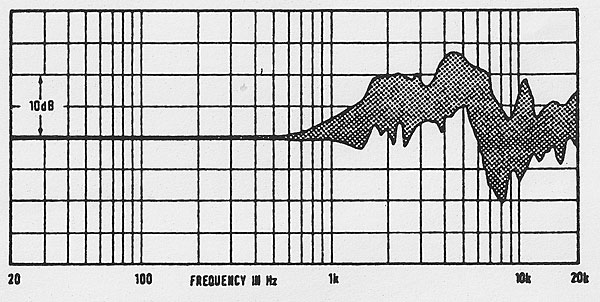| Columns Retired Columns & Blogs |
Stax SR-Lambda Pro headphones Headphone Frequency Response
Sidebar 1: Headphone Frequency Response
Footnote 1: "Improved Real-Ear Tests for Stereophones," Jon R. Sank, JAES, April 1980. See also "On the Standardization of the Frequency Response of High Quality Studio Headphones," Günther Theile, JAES, December 1986; and "Headphones: As Close As You Can Get," Edward M. Long, Audio, April 1991.
There is a fundamental difference between headphone listening and any other listening experience. With headphones, whether of the on-the-ear or around-the-ear type (that's what the "circumaural" in the specs means), the auditory canal is more or less on the axis of the headphone's diaphragm. In all other listening, much of the sound enters the ear only after reflecting off the pinna (ear lobe) and head. This factor alone drastically affects the frequency response perceived by the ear/brain.
John R. Sank, in a paper in the April 1980 Journal of the Audio Engineering Society (footnote 1) points out what has been known for over 30 years: that a person placed within a uniform frequency-response soundfield will be measured to have a real-ear response that is markedly non-uniform. Fig.1, from Mr. Sank's paper, shows the real-ear response obtained for nine pairs of ears under these test conditions. These curves tell us that for the ear/brain to perceive a flat response the response in the auditory canal must have a response boost in the presence region of 2–5kHz, a slight dip in the 8kHz region, and miscellaneous peaks and dips above 8kHz that average out to flat response from 10kHz to 20kHz (footnote 2).
When we listen to "flat" loudspeakers, the head and pinna automatically equalize the flat response to the requisite response shape inside the ear. But if we listen to a flat-response headphone, it will be perceived as lacking in presence and as having too much high end. Actually, as is evident from fig.1, no two ears are exactly alike in how they affect frequencies above 1kHz. This is because there are individual variations in the size and shape of the external ear's parts.

Fig.1 Envelope of desired headphone response (after Sank).
Another sobering thought comes to mind. The cartilage in our noses and ears continues to grow during our lifetime, so if we live long enough we all tend to have hook noses and big ears. And as the size of our ears increases, our perception of instrumental timbres changes! This happens so slowly that most of us are unaware of the change—even if we notice that "things don't sound the way they used to," we assume the change is due to the normal loss of hearing with advancing age.
Headphone manufacturers need to be fully cognizant of the facts of life reflected in John Sank's graph, and should incorporate equalized responses in their designs. Preference should also be given to real-ear testing of headphones over the use of a flat-plate coupler. A flat-plate coupler is nothing more than a metal or wood panel with a microphone fitted into a central hole. It is a crude attempt to simulate the acoustic impedance of a real ear. Couplers specified by standards-setting organizations for use in headphone testing are generally chosen because they yield reproducible data and are easy to use. But above about 700Hz their response curves differ so much from the real ear response as to be worthless.—Dick Olsher
Footnote 1: "Improved Real-Ear Tests for Stereophones," Jon R. Sank, JAES, April 1980. See also "On the Standardization of the Frequency Response of High Quality Studio Headphones," Günther Theile, JAES, December 1986; and "Headphones: As Close As You Can Get," Edward M. Long, Audio, April 1991.
Footnote 2: This line of reasoning makes me uneasy. Every attempt in the past to "compensate" for frequency-response deviations measured in the outer ear has succeeded only in over-compensating for what our brain has long since come to accept as normal "flat" response. In fact, most headphones that sound flat measure fiat or, if anything, measure rolled-off at the high end.—J. Gordon Holt
- Log in or register to post comments




































